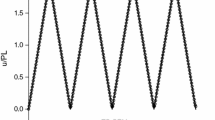Abstract
The present work discusses a solution procedure for heterogeneous media three-dimensional potential problems, involving nonlinear boundary conditions. The problem is represented mathematically by the Laplace equation and the adopted numerical technique is the boundary element method (BEM), here using velocity correcting fields to simulate the conductivity variation of the domain. The integral equation is discretized using surface elements for the boundary integrals and cells, for the domain integrals. The adopted strategy subdivides the discretized equations in two systems: the principal one involves the calculation of the potential in all boundary nodes and the secondary which determines the correcting field of the directional derivatives of the potential in all points. Comparisons with other numerical and analytical solutions are presented for some examples.
Similar content being viewed by others
References
Azevedo JPS and Wrobel LC (1988). Non-linear heat conduction in composite bodies: a boundary element formulation. Int J Numer Methods Eng 26: 19–38
Bialecki R and Khun G (1993). Boundary element solution of heat conduction problems in multizone bodies of nonlinear materials. Int J Numer Methods Eng 36: 799–809
Carrer JAM, Telles JCF (1988) A boundary element formulation for inelastic torsion of variable diameter solids of revolution. In: ICES’88—2nd international conference on computational engineering science, Atlanta, USA
Cavalcanti MC and Telles JCF (2003). Biot’s consolidation theory—application of bem with time independent fundamental solutions for poro-elastic saturated media. Eng Anal Boundary Elements 27: 145–157
Clements DL and Larsson A (1993). A boundary element method for the solution of a class of time dependent problems for inhomogeneous media. Commun Numer Methods Eng 9: 111–119
Gipson GS (1987) Boundary element fundamentals—basic concepts and recent developments in poisson equation. Computational Mechanics Publications, Southampton
Kassab AJ and Divo E (1996). A generalized boundary integral equation for isotropic heat conduction with spatially varying thermal conductivity. Eng Anal Boundary Elements 18: 273–286
Lambe TW and Whitman RV (1979). Soil Mechanics, SI Version. Wiley, New York
Luiz TF, Telles JCF (2004) An application of the boundary element method to steady state potential problems in heterogeneous media (in Portuguese). XXV Iberian Latin-American congress on computational methods in engineering—CILAMCE 2004 Brazil
Neitzel BMT (1997) Three-dimensional boundary element elastoplastic analysis using implicit techniques (in Portuguese). D.Sc. Thesis, COPPE/Federal University of Rio de Janeiro, Brazil
Shaw RP and Gipson GS (1996). A BIE formulation of linearly layered potential problems. Eng Anal 16: 1–3
Sutradhar A and Paulino GH (2004). A simple boundary element method for problems of potential in non-homogeneous media. Int J Numer Methods Eng 60: 2203–2230
Telles JCF (1985) On inelelastic analysis algorithms for boundary elements. In: Cruse TA, Pifko AB, Armen H (eds) Advanced topics in boundary elements analysis, vol 72. ASME, AMD, New York, pp 35–44
Telles JCF and Carrer JAM (1994). Static and transient dynamic nonlinear stress analysis by the boundary elements method with implicit techniques. Eng Anal Boundary Elements 24: 65–74
Telles JCF (1987). A self-adaptative co-coordinate transformation for efficient numerical evaluation of general boundary element integrals. Int J Numer Methods Eng 24: 957–973
Author information
Authors and Affiliations
Corresponding author
Rights and permissions
About this article
Cite this article
Luiz, T.F., Telles, J.C.F. Application of the boundary element method to three-dimensional potential problems in heterogeneous media. Comput Mech 42, 431–440 (2008). https://doi.org/10.1007/s00466-008-0253-7
Received:
Accepted:
Published:
Issue Date:
DOI: https://doi.org/10.1007/s00466-008-0253-7




